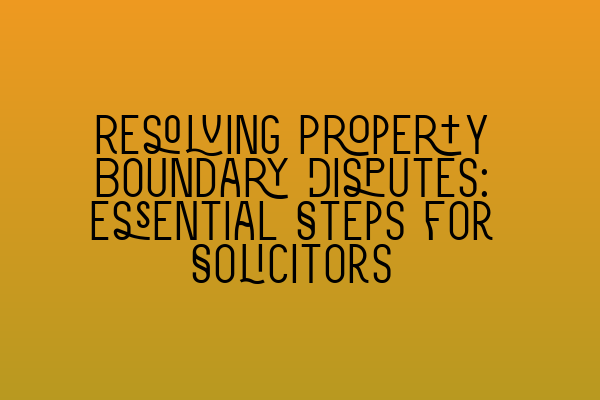Resolving Property Boundary Disputes: Essential Steps for Solicitors
Property boundary disputes can be a source of immense stress and conflict for both property owners and tenants. As a solicitor specializing in property law, it is your duty to guide your clients through the process of resolving these disputes in a fair and amicable manner. In this article, we will discuss the essential steps for solicitors to effectively resolve property boundary disputes.
Step 1: Understanding the Issue
The first and most crucial step in resolving a property boundary dispute is to fully understand the issue at hand. This involves conducting a thorough investigation into the property boundaries, examining title deeds, plans, and any other relevant legal documents. By gaining a clear understanding of the situation, you will be better equipped to advise your client on the appropriate course of action.
Step 2: Mediation
Before resorting to legal proceedings, it is often advisable to attempt mediation between the parties involved in the dispute. Mediation allows for open communication and negotiation, with the aim of reaching a mutually acceptable resolution. As a solicitor, you can play a vital role in facilitating this mediation process and guiding your client towards a satisfactory outcome. By avoiding litigation, both parties can save time, money, and preserve their relationship.
Step 3: Expert Assessment
If mediation fails to produce a resolution, it may be necessary to seek an expert assessment of the property boundaries. Engaging a professional surveyor or land specialist can provide objective evidence and expert opinion on the correct position of the boundaries. This assessment can form the basis for further negotiations or legal action if required.
Step 4: Legal Action
If all else fails, and the dispute cannot be resolved through mediation or expert assessment, legal action may be necessary. As a solicitor, you will need to prepare the necessary legal documents, advise your client on the best course of action, and represent them in court if the matter proceeds to litigation.
In pursuing legal action, it is essential to thoroughly research and present a strong case, supported by relevant evidence. This may include witness statements, expert reports, and any other relevant documentation. Your expertise as a property law solicitor will be instrumental in navigating the complexities of the legal system and ensuring the best possible outcome for your client.
Step 5: Enforcement of a Judgment
If the court rules in favor of your client, it is important to take the necessary steps to enforce the judgment. This may involve obtaining an injunction, transferring or adjusting property boundaries, or seeking monetary compensation. As a solicitor, your role is to advise your client on the available enforcement options and guide them through the process to ensure a successful outcome.
Conclusion
Resolving property boundary disputes is a complex and challenging task, requiring expert legal knowledge and strong negotiation skills. By following these essential steps, you can effectively guide your clients through the process, aiming for a fair and satisfactory resolution. Remember, each case is unique, and it is crucial to adapt your approach according to the specific circumstances at hand.
If you are preparing for SQE exams or looking for additional resources to enhance your knowledge of property law, consider exploring our related articles:
